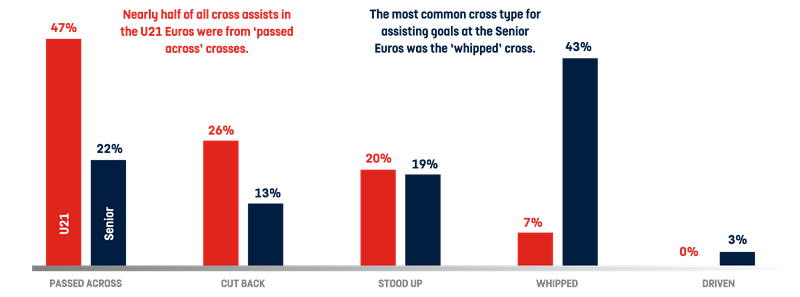In this blog, Simon Houston, The FA’s game insights analyst and Mark Neville, The FA’s youth coach developer talk about some key insights from the Euros tournaments and how these can be applied to coaching sessions with young players.
How do we as coaches plan game-realistic finishing sessions?
In this blog series we have assessed certain finishing headlines, finishing techniques and build-up play from both the U21 and senior Euros this summer, then discussed how they can be interpreted to influence practice design with younger players. Within this blog, we’ll explore how crossing insights within these tournaments may influence your planning for finishing sessions.
The findings…
We know that crossing has always been an important part of the game, but what do we actually mean by a ‘cross’, and how often do they assist goals?

As we can see in the above graphic, crossing was a prominent way to assist goals. This gives us insight that 3 of every 10 open plays goals within the senior Euros featured a cross directly before the goal-scoring finish.
The next question to ask is, what does a cross look like? What we may traditionally think of as a ‘whipped’ ball in the air is not the only way we can deliver into the box from wide areas.
The types of crosses measured are:
- Passed across - a targeted delivery on the ground with the inside of the foot.
- Cut back - a delivery that travels backwards within 12 yards of the by-line and the 18-yard box.
- Stood up - a floated aerial delivery for a teammate.
- Whipped - a delivery with the inside of the foot, above waist height with the intention to curl the ball.
- Driven - a straight delivery with pace off the ground.
The graph below shows that by far the most common type of crossed assists in the U21 Euros was passed across. This type of cross, when combined with cut backs, accounted for nearly 3 out of every 4 crossed assists. The senior Euros showed a somewhat different profile, as whipped crosses provided almost half all crossed assists in the tournament (43%).
The cross types data below shows the extent to which this aspect of the game can vary massively between two different levels of the game. The same may be true for the teams we work with at grassroots or youth level.

Now we’ve assessed the prominence of crossing, and the types of crosses that assist goals, the final element to unpack is exactly where the crosses are delivered from.

Crossed assists were grouped into three categories based on where they were delivered from: inside box, wide and deep. In the U21 Euros, inside box crosses accounted for 6 of every 10 goals that were assisted by crosses, wide crosses were less common but still accounted for around a quarter of all crossed assists, and the least common area was deep.
Inside box crosses were also the most common area for crossed assists in the senior Euros. However, deep crosses were almost as common, accounting for nearly 4 of every 10 crossed assists.
Mark Neville has observed this data and considered how it could impact coaches when considering practice design. His thoughts are summarised in 3 key areas:
The prominence of crossing
If in the senior Euros, a third of open play goals come from a cross, to what extent do we allow the players to practice the skills required to master these situations, and at what stage of their development is this introduced? The data doesn't tell us when we cross or why we cross, but it provides an excellent platform for further investigation.
Variety of crossing
The data we've seen potentially dispels some myths and broadens our thinking of what we may typically think of as a cross. Each type comes as the result of tactics and strategies deployed and the affordances of what space has been given to the players as they are crossing the ball.
Technique of crossing
Crossing is fun; it's essentially ball striking, which can be practised at a young age, even if the games don't present these situations as often. A cross is a type of pass, and just like a standard pass, players need to broaden their arsenal to select the correct technique at the right times?
To view the practice Mark created from using these coaching implications, watch this webinar or check out the whole 4-part webinar series here.
What do you think of this blog? Do you have any questions for Simon or Mark? Have you tried out their suggestions? Let us know in the comments below.



-

Mark Neville
-
Cancel
-
Vote Up
0
Vote Down
-
-
Sign in to reply
-
More
-
Cancel
-

Jonathan Arnett
in reply to Mark Neville
-
Cancel
-
Vote Up
0
Vote Down
-
-
Sign in to reply
-
More
-
Cancel
Comment-

Jonathan Arnett
in reply to Mark Neville
-
Cancel
-
Vote Up
0
Vote Down
-
-
Sign in to reply
-
More
-
Cancel
Children